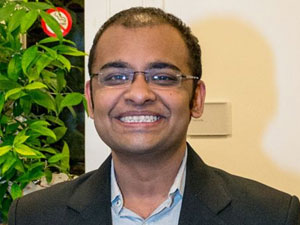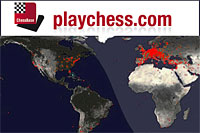
Abhijeet Gupta on Hoogeveen 2015
The dynamics of winning a strong open event are pretty complex. The art of playing back to back rounds, sometimes even double rounds without a rest day, coping with unexpected pairings, engaging against uncomfortable opponents, must-win scenario against lower rated players, taking draws at the right moment to conserve your energy for the final games, strong opening preparation – these are some of the situations that strong players face all the time when playing open tournaments. The best way for us to learn how to play well in an open event is by following the games of players who are successful in such tournaments on a regular basis.
GM Abhijeet Gupta (2629) was the top seed at the 19th Hoogeveen’s International tournament held from the 17th to 24th of October 2015. In a tournament where 17 other grandmasters participated he won the event with a score of 7.0/9, half a point ahead of his nearest rivals. But this is not the only reason why ChessBase decided to interview him. Abhijeet has a knack of winning open events. It may be his playing style, but the number of open tournaments he has finished in first place is quite astonishing – Hoogeveen’s 2015, Commonwealth 2015, Azgamov Memorial 2014, Parsvnath International Open 2014, Commonwealth 2013, Al Ain Classic 2013, Kavala 2012, Philadelphia 2012, Dubai Open 2011, London Chess Classic 2011, the list goes on and on. And we must not forget that he was the World Junior Champion in 2008.
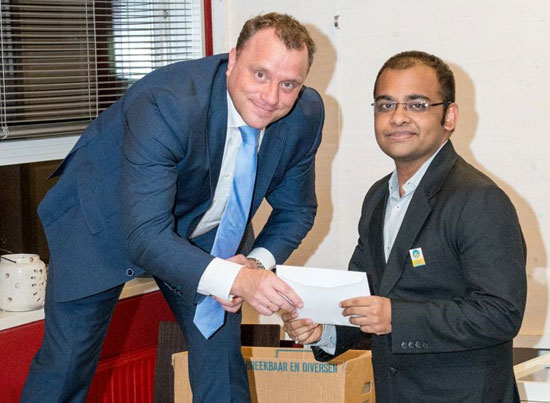
Abhijeet receiving the first prize at the Hoogeveen’s Open 2015
Even though Abhijeet was the top seed at the event he faced stiff competition from strong grandmasters like Erwin L’Ami, Benjamin Bok, Deep Sengupta, Jiri Stocek, Sebastian Bogner, to name just a few. After losing the second round to GM Ankit Rajpara it seemed as if this would be just another event for the talented Indian player. But he did not lose his ambition. Scoring 6.0/7 in the remaining rounds and beating strong players like Neelotpal Das, Jan Werle and Alexander Shabalov, he was able to win the title. In an exclusive interview Abhijeet talks about the Hoogeveen’s tournament, but the careful reader will find many of the secrets that help him win open tournaments on a regular basis.
Sagar Shah: Congratulations Abhijeet for winning the Hoogeveen International Open. Did you think it would happen after your loss in the second round?
Abhijeet Gupta: Thank you so much, Sagar. To be honest it’s always better to start badly in a tournament than to finish one! So I was lucky in that sense. Losing in the second round did wake me up, but as long as there is a theoretical chance to win the event I never lose hope.
SS: What went wrong for you in the second game against Ankit Rajpara?
AG: Well it was just a bad game from my side. I sort of misjudged his b4-b3 idea and never really recovered after that – was simply outplayed.

[Event "19th Hoogeveen Open 2015"] [Site "Hoogeveen NED"] [Date "2015.10.18"] [Round "2.1"] [White "Gupta, Abhijeet"] [Black "Ankit, R. Rajpara"] [Result "0-1"] [ECO "D43"] [WhiteElo "2629"] [BlackElo "2467"] [Annotator "Sagar Shah"] [PlyCount "80"] [EventDate "2015.10.17"] 1. d4 d5 2. c4 c6 3. Nf3 Nf6 4. Nc3 e6 5. Bg5 h6 6. Bh4 dxc4 7. e4 g5 8. Bg3 b5 {The Moscow Variation, one of the sharpest variations in current chess theory. Both the players are ready for a full-blooded fight.} 9. Be2 Bb7 (9... b4 { never really wins a pawn as after} 10. Na4 Nxe4 11. Be5 Nf6 (11... f6 12. Qc2 $1 $18) 12. Bxc4 $44 {White has excellent compensation.}) 10. Qc2 Nbd7 11. Nd2 {This move played by Abhijeet had been tried once before by Tomashevsky against Matlakov in 2014. However, the main move in the position is Rad1. The move Nd2 looks pretty artificial. Abhijeet's idea is to play Nf1-e3. But as we shall see it's too slow.} (11. Rd1 Qb6 12. h4 g4 13. Ne5 {is the main line.}) 11... Qb6 ({Tomashevsky-Matlakov game went} 11... h5 12. h4 g4 13. Rd1 Be7 14. Nf1 Nf8 15. Ne3 Ng6 16. O-O O-O 17. f3 $1 {When White had already snatched the initiative and stood better. 1-0 (65) Tomashevsky,E (2695)-Matlakov,M (2689) Vladivostok 2014}) 12. Rd1 Be7 (12... Qxd4 $2 13. Nxc4 $1 $18) 13. Nf1 $6 { This is logical continuation of 11.Nd2!?, but turns out that Black has a simple way to snatch the initiative.} (13. a4 a6 14. O-O {was more in the spirit of the position.}) 13... b4 $1 14. Na4 b3 $1 {[#]Strong play by Ankit. As Abhijeet said in his interview, he had underestimated this idea of b4-b3.} 15. Qd2 (15. axb3 Bb4+ 16. Nd2 cxb3 17. Qd3 Qb5 $15) 15... Qa6 16. axb3 Nxe4 17. Qc2 Qa5+ 18. Nd2 Nxg3 19. hxg3 cxb3 $17 {Through some excellent moves Black has cemented his advantage.} 20. Qxb3 Rb8 {The idea is to play c5 and then Bxg2, opening an attack against the queen.} 21. Qc2 c5 $1 {Once the bishop comes to life, Black usually equalizes. Here he is simply winning.} 22. d5 exd5 $19 {Black is two healthy pawns up and no matter how hard Gupta tries to complicate matters, Rajpara keeps things under control and brings home the full point.} 23. Nc3 Nf6 24. Qf5 Qb6 25. Kf1 Kf8 26. Re1 Bc8 27. Qc2 Qxb2 { There goes the third one.} 28. Qd3 c4 29. Qd4 Qb6 30. Qe5 Qd6 31. Qd4 Be6 32. f4 Kg7 33. Nf3 Qc5 34. Qd2 Ne4 35. Nxe4 dxe4 36. Nd4 c3 37. Nxe6+ fxe6 38. Qc2 Qd4 39. Rd1 Rb2 40. Qc1 Rd2 {Once White played this ultra ambitious idea of Nd2-f1 and Black executed the moves b4 followed by b3 there was no way that Abhijeet could have made a comeback in the game. His opponent played some flawless chess. It's always difficult to recover from such one-sided games, and the fact that Abhijeet won the tournament speaks volumes about his mental strength.} 0-1
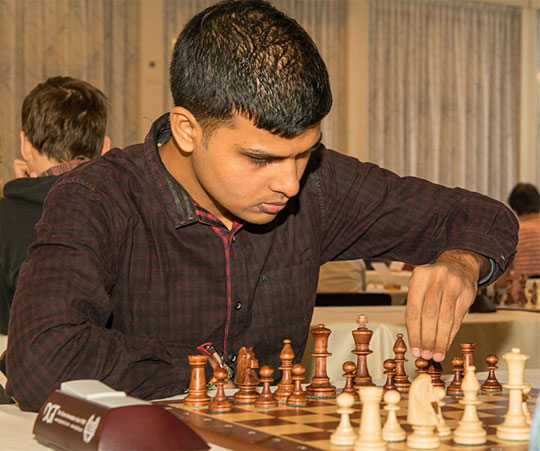
GM Ankit Rajpara not only beat the eventual winner but also played a very solid event
with two wins, six draws, and one loss
SS: After your loss to Ankit you won the next two games and faced Alexander Shabalov in the fifth round. What was your approach when playing a ferocious attacker like him?
AG: Shabalov has always been a difficult opponent for me. I had already lost twice against him before this game. I was bit apprehensive about what variation to choose when he played the King’s Indian Defence, but I relied on knowledge and skills, which prevailed in the end. By the way, the position that was reached on move 23 in the game was prepared to some extent by me prior to the encounter! This made it easier for me to outplay him.

[Event "19th Hoogeveen Open 2015"] [Site "Hoogeveen NED"] [Date "2015.10.20"] [Round "5.3"] [White "Gupta, Abhijeet"] [Black "Shabalov, Alexander"] [Result "1-0"] [ECO "E90"] [WhiteElo "2629"] [BlackElo "2522"] [Annotator "Sagar Shah"] [PlyCount "67"] [EventDate "2015.10.17"] 1. d4 Nf6 2. c4 g6 3. Nc3 Bg7 4. e4 d6 5. Nf3 $5 {Abhijeet Gupta is a connosseiur of the Saemisch Variation in the King's Indian. He does play the h3 Variation (11 games in the Mega with nine wins for Abhijeet) but just not as often.} O-O 6. h3 e5 7. d5 Nh5 8. g3 {The longterm trumps of space and free development of pieces lie with White. Black on the other hand has castled and is ahead in development. He must open the position as soon as he can.} f5 9. exf5 gxf5 10. Nh4 {After following Tomashevsky's idea of Nd2 in his game against Ankit Rajpara, Abhijeet follows the Russian Champion's footsteps once again. But it looks more of a coincidence than something that was preplanned.} (10. Nxe5 $2 Qe8 $1 $19) (10. Ng5 {is an alternate line.} Qe8 11. Be2 Nf6 12. Be3 {is another way to play this position.}) 10... Qe8 11. Be2 Nf6 12. Bg5 { What exactly is the role of the bishop on g5? It probes the kingside – in a way tempting Black to play h6, when the light squares around his king would be further weakened.} Na6 (12... h6 13. Be3 $1 $16 {The g6 square has been weakened and Qd2 will attack the h6 pawn. Provoking h6 was good for White.}) 13. Qc2 Nb4 14. Qd2 a5 15. a3 Na6 16. Qc2 Nc5 17. Be3 (17. Nxf5 $2 Bxf5 18. Qxf5 Nfe4 $19) 17... e4 (17... Bd7 $5 18. Bxc5 dxc5 19. Nxf5 Bxf5 20. Qxf5 Nxd5 21. Qe4 Nxc3 22. bxc3 Rd8 23. O-O {White maintains an edge here because of his safer king position and his bishop can be more active on e4 later. But I can hardly imagine him to be seriously better.}) 18. O-O-O Nfd7 19. Kb1 Ra6 20. Nb5 {Both sides have their share of weaknesses, but it seems that the holes in Black's position are much more. The knights are coming to d4 and f4 to get to the e6 square.} Qd8 21. Ng2 c6 22. Nd4 Ne5 23. Nf4 {[%csl Gc5,Gd4,Ge5,Gf4] A unique position with all the knights well placed on central posts. As Abhijeet said after the game, he had a similar position on his laptop before the game. Just goes to show the high level of preparation that this guy indulges in.} Bd7 24. g4 $1 {Extremely alert and excellently played!} cxd5 (24... fxg4 25. hxg4 { with the threat of Nde6 – this looks extremely strong.}) 25. cxd5 (25. Nxf5 { was stronger as after} Ba4 26. Qd2 Ned3 (26... Bxd1 27. Qxd5+ Kh8 28. Rxd1 $18) 27. Nxg7 Kxg7 28. Nxd3 exd3 29. Bxd3 $18 {White is winning.}) 25... Ba4 26. Qd2 Ncd3 (26... Bxd1 27. Rxd1 $16 {The rooks don't really matter in this position. It's the knights and bishops that can cause maximum damage here.}) 27. Bxd3 exd3 28. Rc1 Rb6 29. Nfe6 Qf6 30. Nxg7 f4 31. Nh5 Qg6 32. Nxf4 Qe4 33. f3 Bc2+ 34. Ka1 {A wonderful strategic game by Abhijeet. He was able to outplay his experienced opponent in a tense complicated middlegame, something which is not easy when the person sitting opposite you is Alexander Shabalov.} 1-0
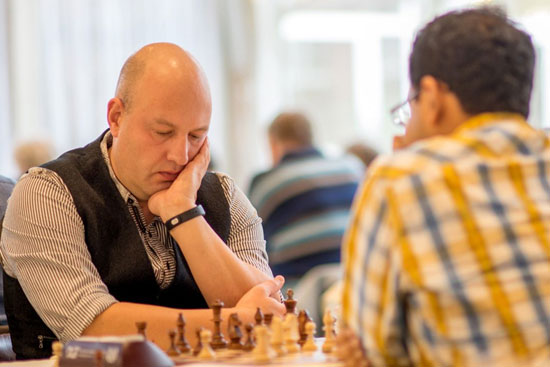
Alexander Shabalov tried his best to muddy the waters, but Abhijeet kept complete control
SS: In game six you made a quick draw with Vishnu Prasanna with the black pieces. Did you notice that you had made an opening blunder just before you split the point?
AG: I had forgotten my theory and made a mistake of playing 13…Nd7 instead of 13…Ke7. I felt that even after I lose a piece I had some chances to hold, but the computer calmly refutes all of Black’s attempts. After my opponent played 14.Qb3 and offered a draw I accepted it. I wasn’t feeling too well before the game, and there were still three more games to go, so I didn’t really see the point of risking so much at that time.

[Event "19th Hoogeveen Open 2015"] [Site "Hoogeveen NED"] [Date "2015.10.21"] [Round "6.2"] [White "Vishnu Prasanna, V."] [Black "Gupta, Abhijeet"] [Result "1/2-1/2"] [ECO "D37"] [WhiteElo "2503"] [BlackElo "2629"] [Annotator "Sagar Shah"] [PlyCount "27"] [EventDate "2015.10.17"] 1. d4 Nf6 2. c4 e6 3. Nf3 d5 4. Nc3 dxc4 {This is the only time that Abhijeet has played the Vienna in his life.} 5. e4 Bb4 6. Bg5 c5 7. Bxc4 cxd4 8. Nxd4 Bxc3+ 9. bxc3 Qa5 10. Bxf6 Qxc3+ 11. Kf1 gxf6 (11... Qxc4+ 12. Kg1 Nd7 (12... gxf6 $2 13. Rc1 $18) 13. Bxg7 Rg8 14. Rc1 Qa6 15. Bh6 $16 {The position is clearly in White's favour.}) 12. Rc1 Qa5 {This has been seen in many games and Black is scoring pretty well. From the numerous options available here Vishnu chooses the move Bb5+.} 13. Bb5+ Nd7 $2 (13... Ke7 $1 {is the main move played by great players like Morozevich, Ivanchuk, Jakovenko, etc. Black is doing pretty well in the position.}) {[#]} 14. Qb3 $6 {The players agreed to a draw at this point, although it must be mentioned that Black has a pretty decent position after 0-0. White simply missed a very strong continuation at his disposal.} (14. Rxc8+ $3 {would have given White a nearly decisive advantage.} Rxc8 15. Bxd7+ Ke7 (15... Kxd7 16. Nb3+ $18 {loses the queen.}) 16. Bxc8 Rxc8 { Abhijeet thought that he had decent compensation here. While this is true for humans because Black has an extra pawn, the a2 pawn is hanging and also the rook on h1 will take time to come into the game. But for the silicon monster it just takes a few seconds to determine that White is just winning after} 17. Ke2 $1 Rd8 (17... Qxa2+ 18. Qd2 $18) 18. Qd3 $1 Qxa2+ (18... e5 19. Nf5+ $18) 19. Ke3 $18 {The rook comes out next move and the game is almost over.}) (14. Qb3 O-O $1 15. h4 Qb6 16. Ne2 Nc5 17. Qe3 $13 {The position is complex with chances for both sides.}) 1/2-1/2

GM Vishnu Prasanna must be kicking himself for missing the Rxc8 tactic
SS: In the seventh round it seemed like you completely outplayed GM Jan Werle, right out of the opening. Can you tell us more about that game?
AG: The problem for Jan was that he ended up in a really passive position out of the opening, where Black literally doesn’t have any active plans. These positions are always difficult to play. I managed to find this natural plan of pushing my h-pawn to h6 and probably already after that I am much better.

[Event "19th Hoogeveen Open 2015"] [Site "Hoogeveen NED"] [Date "2015.10.22"] [Round "7.1"] [White "Gupta, Abhijeet"] [Black "Werle, Jan"] [Result "1-0"] [ECO "E06"] [WhiteElo "2629"] [BlackElo "2524"] [Annotator "Sagar Shah"] [PlyCount "61"] [EventDate "2015.10.17"] 1. d4 Nf6 2. c4 e6 3. g3 d5 4. Bg2 Be7 5. Nf3 O-O 6. O-O dxc4 7. Qc2 a6 8. a4 Bd7 9. Qxc4 Bc6 10. Bg5 {Recently we have seen two very important white wins in this line at the top level – Nakamura beating Anand and Giri getting the better of Leko.} a5 (10... Bd5 11. Qd3 c5 12. Nc3 Bc6 13. Rfd1 {is the other main line.}) 11. Nc3 Na6 12. Bxf6 Bxf6 13. e4 Nb4 14. Rfd1 b6 15. Qe2 Bb7 16. Rac1 {White has the freer game. He has centre control and his pieces are well placed. However, Black has the bishop pair and quite a solid game.} g6 17. h4 { In the next few moves Abhijeet tries to improve his position little by little without doing anything drastic.} Bg7 18. Qe3 Qe7 19. h5 Rfd8 (19... gxh5 {The computer prefers this move but humans tend to reject such moves as on the surface they looks pretty ugly. But here it is difficult to recover the pawn and Black looks better.} 20. Qf4 Rad8 $17) 20. h6 $1 {Such pawns are always a big headache for the opponent.} Bf8 21. Ne5 c5 $6 {White is much better placed for this opening of the position.} 22. Nb5 (22. Ng4 $5 cxd4 23. Rxd4 $14) 22... Nc6 (22... Rac8 $142) 23. Ng4 e5 24. dxc5 bxc5 25. Rd5 $1 Bc8 $6 {The game comes to an abrupt end now.} (25... Rab8 $14) 26. Rdxc5 $1 Bxg4 27. Rxc6 { White is a pawn up without any compensation.} Qb4 28. Nc7 Rac8 29. Nd5 Qxa4 30. Rxc8 Bxc8 (30... Rxc8 31. Nf6+ Kh8 32. Nxg4 $18) 31. Qg5 $1 {A smooth victory for the Indian grandmaster.} (31. Qg5 Re8 (31... Rxd5 32. exd5 $18) 32. Nf6+ $18) 1-0

Jan Werle lost to Abhijeet and L’Ami but was able to beat strong
players like Deep Sengupta and Debashis Das to finish fourth
SS: What was your approach to the final round? How did you beat your grandmaster opponent in just 20 moves?
AG: I just wanted to get a normal position out of the opening, try to play a long game and see how it goes from there. But Neelotpal Das really messed it up in the opening, and by move 15 I was already winning. I had prepared 9.Ne5! at home. If White can get away with 9…Qxd4 then the knight jump to e5 has to be good, as I get a better version in all lines compared to 9.0-0. I think 9.Ne5 is a strong move. Besides the second round game I showed pretty decent chess in this tournament. So it’s difficult to choose my favourite game, but if I had to, I would probably go for this last round battle because it enabled me to win the event.

[Event "19th Hoogeveen Open 2015"] [Site "Hoogeveen NED"] [Date "2015.10.24"] [Round "9.2"] [White "Gupta, Abhijeet"] [Black "Neelotpal, Das"] [Result "1-0"] [ECO "E01"] [WhiteElo "2629"] [BlackElo "2475"] [Annotator "Sagar Shah"] [PlyCount "39"] [EventDate "2015.10.18"] {This last round victory helped Gupta to claim the title. Little would he have known that he would be able to beat his grandmaster opponent in just 20 moves. } 1. d4 Nf6 2. c4 e6 3. g3 d5 4. Bg2 Bb4+ 5. Nd2 O-O 6. Ngf3 dxc4 7. Qc2 b5 ( 7... Nc6 {is the other possibility.}) 8. a4 bxa4 9. Ne5 $1 {Excellent piece of homework. As Abhijeet explained: if Black cannot take on d4 with his queen then White gets a superior version of the 9.0-0 line.} (9. O-O {is the main move played once by Boris Gelfand, but Abhijeet has a new idea up his sleeve.} Bb7 10. Nxc4 c5 $13) 9... Nd5 ({The real test of Abhijeet's idea was} 9... Qxd4 {but after} 10. O-O $1 Qxe5 11. Nxc4 Qb5 12. Bxa8 {White has a clear advantage. } c6 {The bishop cannot be trapped on a8 as after} 13. Rxa4 $1 Ba6 14. b3 $16 { White is better.}) 10. O-O Bb7 11. Ndxc4 $16 {White is just clearly better. The a4 pawn will soon fall and then the a7 and c7 pawns would be weak.} c5 12. e4 Nf6 13. dxc5 (13. d5 {was also quite powerful.} exd5 14. exd5 Nxd5 15. Rd1 $18) 13... Bxc5 14. Rd1 Qe7 (14... Qc7 {was preferable.} 15. Bf4 Nh5 16. Bd2 $16 {White has an advantage but not as huge as in the game.}) 15. Bg5 h6 16. Bxf6 Qxf6 (16... gxf6 17. Ng4 $18) 17. Nd3 {Threatening e4-e5.} Na6 (17... Bd4 18. Nd6 Bc6 19. e5 Bxe5 20. Bxc6 Nxc6 21. Qxc6 $18) 18. Na5 $1 {The bishop on b7 has nowhere to go and the next move after taking it White goes e4-e5.} Qe7 19. Nxb7 Qxb7 20. Qxa4 $1 {The knight on a6 cannot be defended, and if it moves, the c5 bishop falls and hence White wins a piece. An easy victory for Gupta thanks to some high class opening prepation.} (20. e5 {was also strong but Abhijeet finds the easiest way to win.}) 1-0

Right out of the opening GM Neelotpal Das (right) was on the backfoot
and was a victim of Gupta’s excellent home preparation
SS: You have a knack of winning strong open events: Hoogeveen 2015, Commonwealth 2015, Azgamov Memorial 2014 Parsvanath Open 2014, Commonwealth 2013, Al Ain Open 2013, World Juniors 2008. The list is endless. Do you think you have specific way of approaching crucial games that helps you to win these events?
AG: To be honest in the last 18 months I have lost many more final round games than I have won! So ideally it’s not as high as I would like it to be. Generally the best thing you can do while approaching these crucial games is to just forget about the tournament situation, and go play your natural stuff, but I can tell you from my own experience that it’s easier said than done. I just try to follow this – sometimes it works, sometimes it doesn’t!

Things worked out well for Abhijeet as he not only won €3,000 but also
the chance to pose with this beautiful painting. Yes, only pose, it was not a prize!
SS: You have excellent results in the Catalan Opening from the white side. In Hoogeveens too you were able to beat Jan Werle and Neelotpal Das. Can you tell us the secret of how you achieved this expertise?
AG: I am glad that you feel like that, but in general it all depends on how much work you have put in a particular position. I did some homework in the Catalan, and luckily for me it paid dividends in this event.
SS: What are your next tournaments?
AG: I am going to play in the inter-Petroleum tournament where I will be representing Bharat Petroleum Company Limited (BPCL) and after that I will be playing in a couple of opens in Philippines.
SS: What are your aims in the near future and also your ultimate goal in chess?
AG: I don’t have an ultimate aim because I feel it’s always too far-fetched. Instead I try to work towards small and doable goals first. Right now my aim is to get back into the top 100 and try to play as consistently as I can.
SS: Thanks a lot Abhijeet, for sharing your invaluable knowledge with the readers of ChessBase.
AG: Always a pleasure, Sagar!

GM Deep Sengupta (2580) from India finished as the runner-up in the tournament. Deep played a fine event scoring 6.5/9. He lost his sixth round game against GM Jan Werle, but he got the better of strong opponents like Alexander Shabalov (2522), Debashis Das (2501), and Stelios Halkias (2534). Deep sent us his game against GM Alexander Shabalov with the words, “I like this game very much because it was a fine victory with very few errors.”

[Event "19th Hoogeveen Open 2015"] [Site "?"] [Date "2015.10.20"] [Round "3"] [White "Sengupta, Deep"] [Black "Shabalov, Alexander"] [Result "1-0"] [ECO "B67"] [WhiteElo "2580"] [BlackElo "2519"] [Annotator "Deep Sengupta"] [PlyCount "89"] 1. e4 c5 2. Nf3 d6 3. d4 cxd4 4. Nxd4 Nf6 5. Nc3 Nc6 6. Bg5 e6 7. Qd2 a6 8. O-O-O Bd7 9. f3 b5 (9... Be7 {is the main move, but the text move is also played from time to time by strong players}) 10. Nxc6 Bxc6 11. Ne2 Bb7 12. Nd4 Be7 13. h4 h6 14. Be3 h5 {is a typical idea of this variation} (14... Nd7 {was played in the game: Sukandar,I - Hou,Y Guangzhou 2010}) 15. Kb1 Rc8 16. Bg5 Qc7 17. Bd3 {Basically I was just waiting for my opponent to decide with the king. Sooner or later Black will run out of useful moves and then he has to decide about the king.} Rd8 (17... d5 18. e5 Nd7 (18... Qxe5 19. Bf4 Qxd4 20. Bxb5+ $18) 19. Bxe7 Kxe7 20. Qg5+ Kf8 21. f4 {with a strong attack}) 18. Rhe1 O-O { Finally!} 19. Rg1 (19. g4 $5 {was very tempting during the game. But since I did not see any active counterplay for Black I decided to just prepare with Rg1.} hxg4 20. Rg1 $40) 19... Kh8 20. Qe2 Rfe8 21. Rdf1 Bc8 22. g4 e5 23. Nb3 ( 23. Nf5 Bxf5 24. gxf5 d5 25. exd5 Rxd5 {White is much better here, but I was not sure how to continue the attack.}) 23... Be6 24. gxh5 Nh7 25. Qg2 Rg8 26. Nc1 Rb8 27. Qd2 Bd8 28. Rg3 Qa7 29. Bxd8 Rbxd8 30. f4 $1 Qe7 31. f5 Qxh4 32. Qg2 Bc4 33. Rg1 Qf6 34. b3 {As it was time trouble I decided to play it safe.} (34. Rg6 $1 {would have ended the game much quicker.} fxg6 35. hxg6 Rge8 36. Bxc4 bxc4 37. Qh3 Kg8 38. Rh1 $1 d5 (38... Kf8 39. gxh7 Kf7 40. Ne2 Rh8 41. Nc3 Qg5 42. Nd5 Rd7 43. Qf1 $18) 39. Ne2 d4 (39... dxe4 40. Ng3 $18) 40. Ng3 Kf8 41. Qxh7 Ke7 42. Nh5 $18) 34... Rb8 35. h6 $2 (35. Rg6 $1) 35... g5 36. fxg6 Rxg6 37. Rxg6 fxg6 38. Bxc4 bxc4 39. Qxg6 cxb3 40. axb3 a5 (40... Qxg6 {was the best try. I think the endgame offered good chances for a draw.} 41. Rxg6 Rd8 42. Na2 Nf8 43. Rf6 Nh7 44. Rf5 Rg8 (44... Rf8 45. Rxf8+ Nxf8 46. Nb4 a5 47. Nc6 Ne6 48. Nxa5 Nc5 49. b4 Nxe4 50. Kb2 Kh7 51. b5 Nc5 52. Kc3 $18 {[%cal Gc3c4,Gc4d5]}) 45. Nc3 Rf8 46. Rxf8+ Nxf8 47. Nd5 Nd7 48. Kb2 Kh7 49. Kc3 Kxh6 50. b4 Kg5 51. Kd3) 41. Nd3 Qe7 42. Nb2 Nf6 43. Rf1 Rf8 44. Nc4 a4 45. Ne3 { [%cal Ge3f5,Gg6g7] With unstoppable threats.} 1-0
Final standings of the Hoogeveen Open
|
Rk
|
Name
|
Rtg
|
Fed
|
Pts
|
Perf
|
|
1
|
GM Gupta, Abhijeet |
2629
|
IND
|
7.0
|
2652
|
|
2
|
GM Sengupta, Deep |
2580
|
IND
|
6.5
|
2636
|
|
3
|
GM Bok, Benjamin |
2591
|
NED
|
6.5
|
2646
|
|
4
|
GM Werle, Jan |
2524
|
NED
|
6.5
|
2588
|
|
5
|
GM l'Ami, Erwin |
2619
|
NED
|
6.0
|
2617
|
|
6
|
GM Vishnu Prasanna. V |
2503
|
IND
|
6.0
|
2600
|
|
7
|
GM Pavlidis, Antonios |
2522
|
GRE
|
6.0
|
2577
|
|
8
|
GM Neelotpal, Das |
2465
|
IND
|
6.0
|
2560
|
|
9
|
GM Pruijssers, Roeland |
2501
|
NED
|
6.0
|
2486
|
|
10
|
GM Ernst, Sipke |
2527
|
NED
|
6.0
|
2529
|
|
11
|
GM Shabalov, Alexander |
2522
|
USA
|
6.0
|
2464
|
|
12
|
IM Schroeder, Jan-Christian |
2519
|
GER
|
6.0
|
2392
|
|
13
|
FM Beerdsen, Thomas |
2313
|
NED
|
6.0
|
2436
|
|
14
|
GM Debashis, Das |
2501
|
IND
|
5.5
|
2519
|
|
15
|
GM Halkias, Stelios |
2534
|
GRE
|
5.5
|
2459
|
|
16
|
GM Ehlvest, Jaan |
2535
|
USA
|
5.5
|
2420
|
|
17
|
GM Stocek, Jiri |
2566
|
CZE
|
5.5
|
2446
|
|
18
|
IM Rudolf, Anna |
2329
|
HUN
|
5.5
|
2372
|
|
19
|
GM Gopal G.N. |
2536
|
IND
|
5.5
|
2426
|
|
20
|
FM Maris, Ivo |
2319
|
NED
|
5.5
|
2358
|
Click for complete standings

The excellent pictures in this report have been taken by Frans Peteers. Frans was born in 1957 and works as a teacher of ICT in Goes (The Netherlands). He is an experienced International Arbiter and sometimes combines this with taking pictures at chess tournaments like the HZ Tournament in Vlissingen and Hoogeveen Open. On his Flickr site you can find more than 26,000 pictures of anything he comes across. He tries to take pictures out of the ordinary with large apertures (big lens openings) so that you get a small depth-of-field and a nice bokeh. You can see some of his portfolio at his official website. For all the pictures taken by Frans from the Hoogeveen 2015 click here. As of now we leave you with four amazing captures by him:

Oh my God, I left the geyser on!
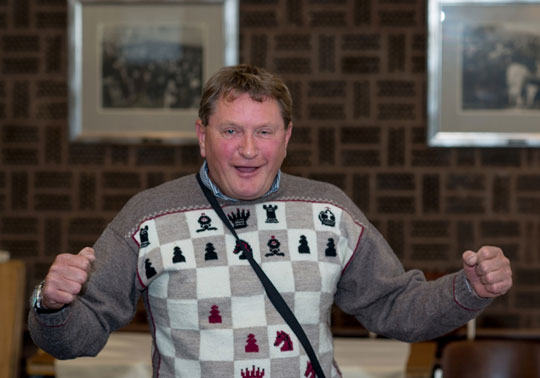
Well, that's one way to smuggle openings prep into the playing hall – really, nobody will notice

Making the neurons work as hard as they can

Timman's my hero – and he is sooo funny!
